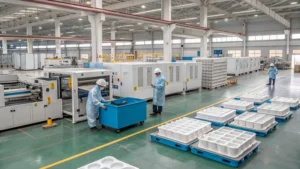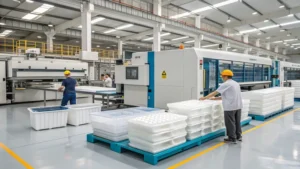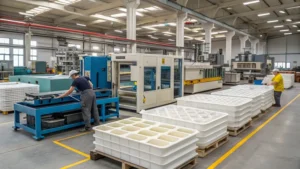
The role of smart sensors in real-time monitoring is pivotal, as they enable continuous data collection and analysis, enhancing efficiency and decision-making across various industries. These advanced devices integrate sensing, processing, and communication capabilities, making them indispensable in modern applications.
Smart sensors play a crucial role in real-time monitoring by collecting, processing, and transmitting data instantly, enabling applications in healthcare, industrial automation, and environmental monitoring.
Understanding the capabilities and applications of smart sensors is essential for leveraging their full potential in real-time monitoring systems. Explore further to discover how different industries benefit from their integration and the technical aspects that make them indispensable.
Smart sensors are essential for real-time monitoring in various industries.True
They provide continuous data collection and processing, enabling timely decision-making and automation.
Smart sensors are only used in industrial settings.False
While prevalent in industry, smart sensors are also widely used in healthcare, environmental monitoring, and smart homes.
What Are Smart Sensors and How Do They Work?
Smart sensors are advanced devices that combine sensing, processing, and wireless communication to collect and transmit data in real-time, making them ideal for applications in IoT, healthcare, and industrial automation.

Smart sensors integrate sensing, processing, and communication capabilities, enhancing efficiency and decision-making across various sectors.
| Feature | Description |
|---|---|
| Sensing | Detects physical parameters like temperature or pressure |
| Processing | On-board microprocessors for data analysis |
| Communication | Wireless transmission via Wi-Fi, Bluetooth, etc. |
Definition and Core Principles
Smart sensors, often referred to as intelligent sensors or sensor nodes, go beyond traditional sensors by not only detecting physical phenomena—such as temperature, pressure, or motion—but also processing and transmitting the data they collect. Equipped with built-in microprocessors, they perform tasks like signal conditioning, noise filtering, and preliminary analytics on-board. This capability allows for real-time data processing and immediate transmission, which is critical in applications requiring timely insights.
The core principles of smart sensors1 include:

-
Sensing: Capturing environmental parameters like humidity or vibration.
-
Processing: Analyzing data using embedded microprocessors.
-
Communication: Sending processed data wirelessly to central systems or cloud platforms.
Classification of Smart Sensors
Smart sensors can be categorized based on several factors:

-
Process: Defined by stages like sensing, processing, and communication.
-
Materials: Vary by type, such as piezoelectric materials for vibration sensors or silicon for MEMS-based sensors.
-
Applications: Used in IoT2 (smart homes), healthcare (wearables), industrial automation, and environmental monitoring.
Smart sensors are more efficient than traditional sensors.True
They process data on-board, reducing the need for external systems and enabling faster response times.
All smart sensors use the same communication protocol.False
Smart sensors employ various protocols like Wi-Fi, Bluetooth, or Zigbee, tailored to specific applications.
What Are the Applications of Smart Sensors in Real-Time Monitoring?
Smart sensors are integral to real-time monitoring3, providing continuous data collection and analysis across diverse industries, enhancing efficiency and decision-making.

Smart sensors are used in healthcare, industrial automation, environmental monitoring, smart homes, and agriculture for real-time data collection, enabling timely interventions and automation.
Healthcare
In healthcare, smart sensors4 in wearable devices monitor vital signs like heart rate and glucose levels in real-time. This allows for remote patient care and early detection of health issues, such as using continuous glucose monitors (CGMs) for diabetes management.
Industrial Automation
In industrial settings, smart sensors monitor machinery health, detecting anomalies like vibrations or temperature spikes to predict maintenance needs. This reduces downtime and boosts efficiency, as seen with vibration sensors in rotating equipment.
Environmental Monitoring
Smart sensors track air quality, water quality, and weather conditions in real-time, supporting sustainability and public health. For example, air quality monitors detect pollutants, alerting authorities to potential hazards.

Smart Homes
In smart homes, sensors enhance security, energy management, and automation by detecting motion or controlling temperature. Smart thermostats, for instance, optimize heating and cooling to save energy.
Agriculture
In agriculture, smart sensors monitor soil moisture and nutrient levels, enabling precision farming. This improves crop yields and reduces resource use, promoting sustainable practices.
Smart sensors improve operational efficiency in industrial settings.True
By predicting maintenance needs and reducing downtime, smart sensors enhance productivity and cost-effectiveness.
Smart sensors are not suitable for remote or hazardous environments.False
Smart sensors are designed for remote and hazardous areas, providing real-time data without human intervention.
What Are the Key Technical Aspects of Smart Sensors?
Understanding the technical intricacies of smart sensors is vital for optimizing their performance in real-time monitoring applications.

Key technical aspects of smart sensors include sensing accuracy, processing power, communication range, and power consumption, which determine their effectiveness in real-time monitoring.
Operational Workflow
The workflow of smart sensors includes:
-
Sensing: Detecting a physical parameter.
-
Signal Conditioning: Amplifying and filtering the raw signal.
-
Analog-to-Digital Conversion (ADC): Converting analog signals to digital.
-
On-Board Processing: Analyzing data with microprocessors.
-
Wireless Communication: Transmitting data to a gateway or cloud.
-
Data Analysis: Enabling real-time insights at the edge or cloud level.
Key Parameters
Performance depends on:

-
Sensitivity: Ability to detect small changes.
-
Resolution: Measurement precision.
-
Response Time: Speed of data collection and transmission.
-
Power Consumption: Critical for battery-operated sensors.
-
Communication Range: Affects deployment in large areas.
-
Data Rate: Impacts latency in real-time monitoring.
Material Compatibility
Materials influence performance:
-
Temperature Sensors: Use thermistors or RTDs.
-
Pressure Sensors: Employ piezoresistive or capacitive materials.
-
Motion Sensors: Leverage piezoelectric or MEMS technology.
Material selection is crucial for smart sensor performance.True
Different materials affect sensitivity, durability, and environmental adaptability.
All smart sensors have the same power consumption.False
Power consumption varies based on sensor type and application needs.
What Are the Advantages and Challenges of Smart Sensors?
Smart sensors offer significant benefits but also face challenges that must be addressed for optimal use.

Smart sensors provide real-time data, energy efficiency5, and remote accessibility but face challenges like high costs and cybersecurity risks.
| Aspect | Advantages | Challenges |
|---|---|---|
| Data Processing | On-board analytics reduce external system load | Complexity in calibration and maintenance |
| Communication | Wireless transmission enables remote monitoring | Vulnerability to cybersecurity threats |
| Cost | Long-term savings through efficiency | High initial investment |
| Energy Efficiency | Optimized power usage | Dependence on reliable power sources |
Advantages
-
Real-Time Data Access6: Enables instant decision-making.
-
Energy Efficiency: Reduces power use with sleep modes.
-
Remote Accessibility: Ideal for hazardous environments.
-
Scalability: Integrates into large monitoring networks.
Challenges
- High Initial Costs: Advanced technology increases upfront expenses.

-
Cybersecurity Risks7: Wireless systems are prone to hacking.
-
Maintenance: Requires regular calibration for accuracy.
-
Power Dependency: Needs reliable power or energy harvesting.
Smart sensors reduce operational costs in the long run.True
By improving efficiency and reducing downtime, smart sensors offer long-term cost savings.
Smart sensors are immune to cybersecurity threats.False
Their wireless nature makes them susceptible to hacking, necessitating robust security measures.
Conclusion
Smart sensors are revolutionizing real-time monitoring by providing continuous, accurate data across industries like healthcare, industrial automation, and agriculture. Their ability to sense, process, and communicate data in real-time enhances efficiency and decision-making. While they offer advantages like energy efficiency and scalability, challenges such as high costs and cybersecurity risks must be managed. Understanding their technical aspects and applications is key to unlocking their full potential.
-
Discover the inner workings of smart sensors and their transformative impact on healthcare and industrial automation. ↩
-
Learn about the integration of IoT with smart sensors and how it revolutionizes data collection and analysis in various sectors. ↩
-
Explore how real-time monitoring enhances efficiency and decision-making across various industries, making it crucial for modern applications. ↩
-
Explore this link to discover cutting-edge innovations in smart sensors that enhance efficiency and performance across various industries. ↩
-
Find out effective strategies to enhance energy efficiency in smart devices, crucial for sustainability and cost savings. ↩
-
Explore how Real-Time Data Access can enhance decision-making and efficiency in various industries. ↩
-
Understand the potential vulnerabilities of smart sensors and how to mitigate cybersecurity threats effectively. ↩








